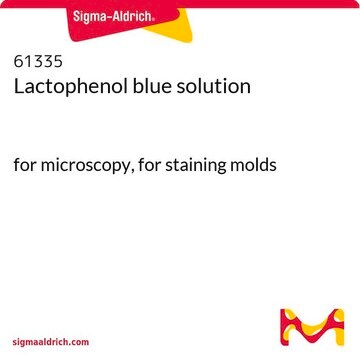18909
Calcofluor White Stain
suitable for microbiology
About This Item
Productos recomendados
Línea del producto
BioChemika
Nivel de calidad
formulario
liquid
composición
Calcofluor White M2R, 1 g/L
Evans blue, 0.5 g/L
técnicas
microbe id | staining: suitable
color
blue to very dark blue
λmáx.
423-443 nm
fluorescencia
λex 423-443 nm in 0.1 M phosphate pH 7.0
aplicaciones
food and beverages
hematology
histology
microbiology
temp. de almacenamiento
room temp
idoneidad
fungi
parasites
yeasts
cadena SMILES
C1=CC=C(C=C1)NC2=NC(=NC(=N2)N(CCO)CCO)NC3=CC(=C(C=C3)C=CC4=C(C=C(C=C4)NC5=NC(=NC(=N5)NC6=CC=CC=C6)N(CCO)CCO)S(=O)(=O)O)S(=O)(=O)O
InChI
InChI=1S/C40H44N12O10S2/c53-21-17-51(18-22-54)39-47-35(41-29-7-3-1-4-8-29)45-37(49-39)43-31-15-13-27(33(25-31)63(57,58)59)11-12-28-14-16-32(26-34(28)64(60,61)62)44-38-46-36(42-30-9-5-2-6-10-30)48-40(50-38)52(19-23-55)20-24-56/h1-16,25-26,53-56H,17-24H2,(H,57,58,59)(H,60,61,62)(H2,41,43,45,47,49)(H2,42,44,46,48,50)/b12-11+
Clave InChI
CNGYZEMWVAWWOB-VAWYXSNFSA-N
Descripción general
Aplicación
Palabra de señalización
Danger
Frases de peligro
Consejos de prudencia
Clasificaciones de peligro
Carc. 1B - Eye Irrit. 2
Código de clase de almacenamiento
6.1C - Combustible acute toxic Cat.3 / toxic compounds or compounds which causing chronic effects
Clase de riesgo para el agua (WGK)
WGK 3
Punto de inflamabilidad (°F)
Not applicable
Punto de inflamabilidad (°C)
Not applicable
Equipo de protección personal
Eyeshields, Gloves, type P3 (EN 143) respirator cartridges
Choose from one of the most recent versions:
¿Ya tiene este producto?
Encuentre la documentación para los productos que ha comprado recientemente en la Biblioteca de documentos.
Los clientes también vieron
Nuestro equipo de científicos tiene experiencia en todas las áreas de investigación: Ciencias de la vida, Ciencia de los materiales, Síntesis química, Cromatografía, Analítica y muchas otras.
Póngase en contacto con el Servicio técnico











